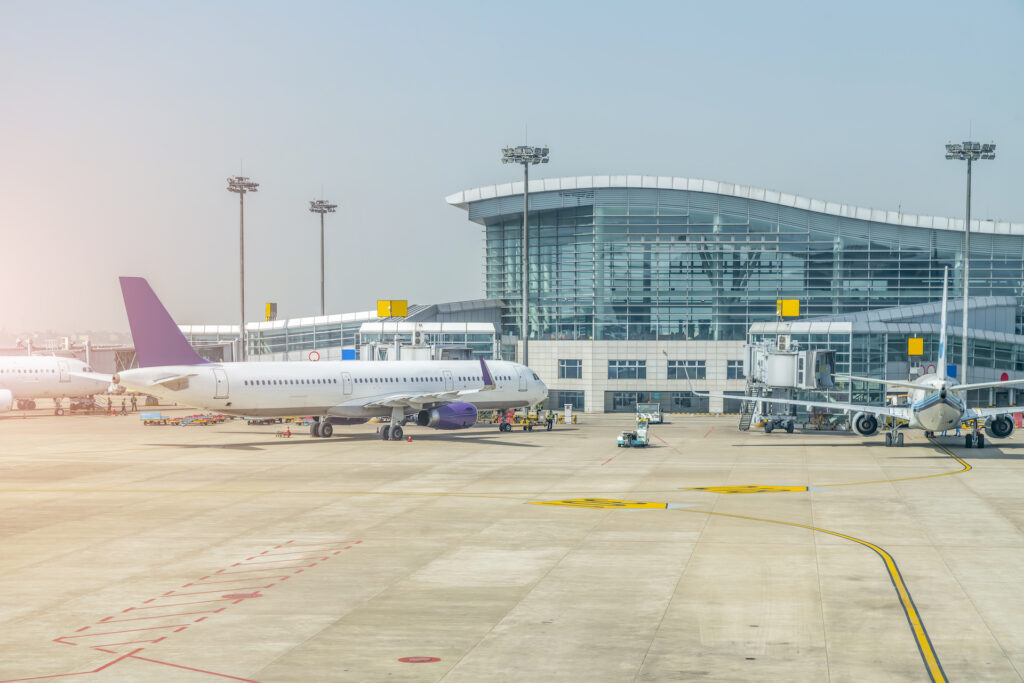6 challenges in airport operations and the modern solutions that seek to address them
Blogs
June 9, 2023

Today, airports play a critical role within the transportation infrastructure networks of all countries, serving as vital conduits of people and goods in an increasingly globalized world. However, keeping airports safe, comfortable, and efficient is a major challenge and one that is becoming more difficult with the increasing popularity of air travel.
In the Philippines, airports face unique issues due to the country's fragmented geography and the uneven distribution of infrastructure-related investments. Additionally, with over 100 million increasingly prosperous Filipinos and thousands of islands, the country has a growing demand for air travel. As it is, this ever-increasing demand has to be met by airports with limited space and outdated facilities, which also have to contend with increasingly unpredictable weather conditions.
For the Philippines to safely provide the needs of the growing number of air passengers, airport operations managers, private businesses, the national government, and the local government units that serve areas around airports need to consider modern solutions that have been tried and tested in other aviation markets. Here, we will look at some of the most pressing challenges in airport operations in the Philippines as well as their potential solutions.
1) Air Traffic Management
One of the primary challenges in airport operations in the Philippines is air traffic management. As more Filipinos travel by air and more foreign tourists and investors visit the Philippines, the skies above the country are starting to become increasingly crowded, particularly around its few major international airports.
Critical airports, such as Manila’s Ninoy Aquino International Airport, are operating at or near capacity, leading to congestion, safety issues, and delays. Compounding these capacity issues is the fact that many airports in the Philippines lack contemporary air traffic control systems, relying instead on outdated technologies and manual processes.
To meet these challenges, the Philippines' Civil Aviation Authority is improving its Communications, Navigation, Surveillance/Air Traffic Management (CNS/ATM) systems. These systems use satellite-based technologies to help air traffic managers optimize routes, reduce aviation fuel consumption, and minimize delays to passengers. The system also enhances safety by providing air traffic controllers with more accurate, up-to-date, information on weather conditions and other hazards—something that is becoming more difficult in the face of climate change.
Moreover, the Department of Transportation as well as transport and mobility infrastructure developers like Aboitiz InfraCapital are continuing the development of new airports and updating the facilities at existing ones. Increasing the number of airports and the capacity of existing gateways can help reduce delays, improving the overall experience for passengers and airline operators.
For example, Mactan-Cebu International Airport (MCIA) in Lapu-Lapu City, Cebu recently opened a new passenger terminal, the MCIA T2. Since the MCIA T2 opened in 2018, it has effectively more than doubled the MCIA’s capacity, keeping delays to a minimum and making the airport the gateway of choice for an increasing number of international travelers.
2) Sustainability
Sustainability is an increasingly critical concern at airports worldwide, and Philippine airports are no exception, especially given the country’s vulnerability to climate change. Aviation is a significant source of carbon emissions, accounting for 3% of the global total. With air travel in the country expected to become more popular than ever, we can expect a significant increase in domestic greenhouse gas emissions.
To address this serious issue, more airports in the Philippines are implementing sustainable technologies and practices. Notably, the previously mentioned MCIA employs 6,300 solar panels to provide sustainable energy throughout its facilities, with many other Philippine domestic and international airports following suit.
Moreover, the Philippine government is now exploring the use of sustainable aviation fuels and the adoption of more fuel-efficient aircraft. The government is also working with various international groups such as the International Civil Aviation Organization to develop sustainable aviation within the Philippines.
3) Security Screening

Even two decades onward, the world continues to be affected by the events of 9/11. This is most evident in the value policymakers give to airport security screening. The Philippines has faced several aviation security threats in recent years, including but not limited to terrorism. The experience of the 9/11 attacks demonstrates the clear danger of these threats, making effective security screening essential not only for ensuring the safety of passengers but people everywhere,
To improve the effectiveness of security screening without severely impacting passengers’ comfort or convenience, airports in the Philippines are deploying an assortment of advanced technologies. These include such solutions as biometric authentication, better X-ray machines, and explosives detection systems.
For example, the Ninoy Aquino International Airport has recently installed new scanners that can detect a wide range of explosives and other threats more accurately than previous-generation technologies. The airport is also exploring the use of biometric authentication to speed up the check-in process and prevent identity fraud often associated with human trafficking.
4) Baggage Handling
Baggage handling is a much more challenging issue for airport managers than many people might expect. Airports are expected to ensure that all passengers’ luggage arrives on time and intact.
Unfortunately, many airports in the Philippines have to contend with outdated baggage handling systems and a growing number of air passengers. As a result, it’s not unusual for luggage at some airports to be misplaced or damaged, seriously eroding trust in local aviation authorities.
To offer better passenger experiences, airports in the Philippines are investing in modern baggage handling systems that leverage automation, robotics, modern management techniques, and real-time tracking to improve efficiency and reliability.
Once again, the Mactan-Cebu International Airport has proven a standout example among Philippine aviation gateways, being equipped with a fully automated baggage handling system capable of processing up to 4,500 bags per hour. This increased automation not only improves turnaround times but also reduces the need for potentially risky manual baggage handling, boosting the overall passenger experience.
5) Transportation Infrastructure Development
Not only do Philippine airports have to contend with aviation-specific operational challenges, but they also face issues related to the country’s limited transportation infrastructure. For instance, many older airports are situated in built-up urban areas with inadequate road networks, forcing passengers and cargo to deal with immense traffic jams and delays. Also, some newer Philippine airports are located far from the population centers they serve, making access difficult and expensive for locals
These issues are already being addressed through a range of infrastructure development projects that are specifically designed to enhance access to the existing and planned airports. In Metro Manila, the recently opened Metro Manila Skyway Stage 3 project, provides a direct link between the Manila Ninoy Aquino International Airport in Pasay and major population centers as far as Quezon City. In Cebu, the proposed Cebu Monorail is specifically envisioned to provide direct access to MCIA. Several LGUs and businesses are likewise in the process of developing or implementing a variety of road or rail solutions that will better connect airports with the population centers that they serve.
6) Emergency preparedness

Lastly, airport operations in the Philippines have to ensure that they are equipped to handle serious emergencies. Airports in the Philippines should be prepared to handle commonplace natural disasters such as floods, typhoons, and earthquakes as well as man-made catastrophes such as cyberattacks and terrorism. Additionally, airports should also be prepared to handle the serious medical emergencies that are bound to become more frequent with increasing air passenger numbers.
However, simply being able to preempt and mitigate emergencies is not enough. Airport operators also have to make sure that their emergency response and mitigation policies do not cause delays or create other negative impacts on the overall passenger experience.
Addressing these various issues is a matter of continuously developing response plans and procedures, as well as conducting periodic training for airport staff and designated emergency response teams. Additionally, airport stakeholders have to invest in equipment and technologies that can help locate and mitigate different types of emergencies as they happen.
With climate change causing erratic weather patterns and global political instability creating potential human threats, airport policymakers in the Philippines will need to exercise prudence and foresight in formulating local response plans. Fortunately, local aviation policymakers can use existing emergency response procedures developed in other countries with mature aviation markets to formulate localized plans that align with international best practices.
Making air travel better for all Filipinos
Operating airports in the Philippines presents numerous human, policy, and technology challenges, ranging from air traffic management and security screening to baggage handling and infrastructure development.
However, the Philippine government, airport authorities, and private businesses like Aboitiz InfraCapital are leveraging modern management techniques and innovative technologies to overcome these challenges. Working together, these and other airport stakeholders are continuously improving the efficiency, safety, and sustainability of airport operations throughout the Philippines.
As Filipinos become more prosperous, the demand for air travel will only continue to grow in the Philippines. Given this, it is essential to continue investing in airport infrastructure development, emergency readiness, sustainable practices, and emerging technologies to ensure the comfort and safety of airport passengers.
By taking these steps, airport stakeholders can meet the needs of passengers and businesses while upholding the highest standards of safety and security. With time, airports in the Philippines will not only serve as critical gateways to the country but also connect people and goods from all points of the globe to destinations the world over.


























